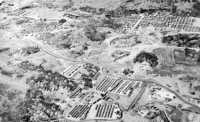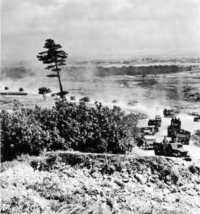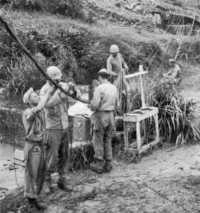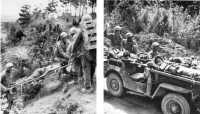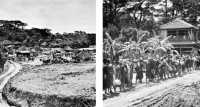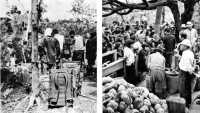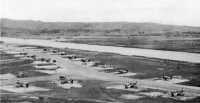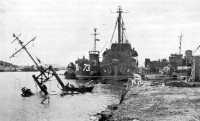Chapter 16: Behind the Front
The stubborn and protracted defense by the Japanese of the fortified Shuri area affected every phase of logistic and other operations in support of the Okinawa campaign, adding unforeseen complications to the execution of a mission which in itself was of great complexity and magnitude. As time passed far beyond the limits set in the plans the quantity of supplies and equipment used increased in direct proportion, while the reduction of the elaborate defenses required the expenditure of inordinate amounts of materiel, especially ammunition. The planned capture of the ports of Naha and Yonabaru for the delivery of cargo failed to materialize and, as a result, the increased supplies required could not be unloaded in sufficient quantities. The carefully integrated shipping schedules for garrison and maintenance supplies were thereby upset. At the same time construction of base facilities was delayed. Difficulties were compounded when, in the last days of May and the early part of June 1945, the invading forces found themselves fighting the weather as well as the enemy. Steady and heavy rains severed land communications on Okinawa, and the motorized Tenth Army was bogged down in the mud. Only through the utmost use of all available resources, energetic improvisation, and resort to water and air transportation was it possible to keep the supplies rolling in to the appointed place in approximately the desired quantities and in time to defeat the enemy.1
As soon as the hilly terrain behind the Hagushi beaches was overrun by American troops, it became the scene of feverish activity. Roads were widened and improved, supply dumps established, antiaircraft guns emplaced, and hundreds of military installations constructed. Tent settlements sprang up everywhere, and the dark green of pyramidal and squad tents became as commonplace a feature of the landscape as the Okinawan tomb. Coral was chopped away from hills and laid on the roads and airfields. Bumper-to-bumper traffic raised clouds of dust on the main thoroughfares in dry weather and splattered along through deep mud in wet. Telephone service soon linked all Army and Navy
Supply and Communications Installations
Large supply installation in Kakazu area
Route 1 near Kadena
Main west-coast telephone cable
installations, and Signal Corps troops also established an elaborate radio communication net and service to American bases in the rear. There were 170,000 Americans on the island a month after the landings, and about 245,000 on Okinawa and neighboring islands at the end of June.2
Supply Operations
Bringing the Supplies Ashore
Unloading of the assault shipping was nearly completed by 16 April, ahead of schedule.3 (See Appendix C, Table 7.) Further progress was satisfactory through 6 May. Thereafter, however, the discharge of supplies failed to keep pace with unloading plans. Between 7 May and 15 June tonnage unloaded was more than 2,00,000 measurement tons behind schedule. However, this was largely offset by the earlier achievements, and the cumulative effect was not evident until 5 June. The chief difficulty was the failure to capture the port of Naha with its harbor and dock facilities as early as planned. Unloading continued for the most part over the reef and beaches in the Hagushi area long after it was expected that they would have been abandoned in favor of rehabilitated port facilities. (See Appendix C, Chart 3.) High winds, heavy rains, frequent air raids, and equipment shortages all contributed to the delays and the cumulative deficiencies. Particularly onerous was the necessity of selective discharge of cargo to bring ashore critical items of supply. Sometimes dock gangs had to be pulled off ships prior to unloading and placed on “hot” ships as emergencies developed. In the face of all these difficulties, more than 2,000,000 measurement tons of cargo were unloaded on Okinawa from 1 April to 30 June, an average of some 22,200 tons a day. (See Appendix C, Table 6.)
To supplement the tonnage unloaded at the Hagushi beaches, Tenth Army developed a number of unloading points at other places along the coasts of Okinawa. Such points were opened between 5 and 9 April in northern Okinawa for close support of III Amphibious Corps in its rapid advance northward during the early stages of the operation. After the marines moved south to take part in the drive against the main enemy position, work was rushed to develop unloading facilities at Machinato on the west coast. By 25 May LCTs were being unloaded at a temporary sand causeway. At the same time, temporary unloading
points were developed on the coast between Machinato and Naha in further support of the III Corps. On 7 June, the port of Naha was opened for the use of LCTs and the rehabilitation of harbor and dock facilities was begun. It was planned that by the end of June the bulk of west-coast tonnage would be unloaded at Naha and that the Hagushi beaches would gradually be abandoned.
Unloading on the east coast of Okinawa began in the middle of April, and use was successively made of beaches at Chimu Bay, Ishikawa, Katchin Peninsula, Awase, and Kuba. Yonabaru was captured on 22 May and supplies were unloaded there on 1 June. A ponton pier was started there for LSTs and smaller craft a week later and was completed on 12 June. In the last stages of the campaign an emergency unloading point was opened at Minatoga on the southeast coast on 9 June and was operated for two weeks.
By 30 June 1945 about 20 percent of all tonnage unloaded on Okinawa had been brought ashore at points other than the Hagushi beaches, amounting to nearly 400,000 measurement tons of cargo. In one respect, however, the use of unscheduled supply points contributed to the delays of unloading: as each new beach was opened in immediate support of the assault, available lighterage, trucks, and personnel were dispersed over a number of places, thereby materially slowing operations at the original unloading points. In addition, much of the cargo handled over the new beaches was not discharged directly from ships but from landing craft that had loaded at previously established dumps at Hagushi, Awase, and Kuba and had sailed down the coast.
As a result of slow unloading, ships awaiting discharge accumulated at the various anchorages and presented fine targets for Japanese air attacks. While strenuous efforts were continuously made to speed unloading operations and return the ships to safer areas, the originally planned schedule of resupply shipping could not be adhered to. Emphasis was placed on calling up ships loaded with supplies that were in great need on the island at the particular time. Calling up only the number of such ships which could be expeditiously handled was not always possible because the requirements were so great, particularly in the case of ammunition ships.4
Delivery of Supplies to the Front
Responsibility for supplying the assault troops passed smoothly, during the initial stages, from division to corps and then to the Island Command, the Army logistic agency, on 9 April. Depot and dump operations for the Island
Command were handled by the 1st Engineer Special Brigade until 24 May, when Island Command took over direct operational control of supply installations. All units normally drew supplies in their organic transportation from the Island Command supply points. These were first established in the area behind the Hagushi beaches, but forward supply points were opened farther south as the action moved toward that end of the island. Initially an ammunition supply point was established for each division, and, as operations progressed, these points were consolidated and new ones set up farther forward.
No unusual difficulties were encountered in moving up supplies to the troops until the latter part of May. When the heavy rains started on 20 May and continued day and night for two weeks, the main supply roads linking the forward and rear areas were washed out and movement of vehicles became impossible. The rainy period, moreover, coincided with the break-through at Shuri that started the troops moving rapidly south away from all established supply points. It became necessary to resort to water transportation to bring supplies to the forward dumps. In the interim the 7th Division, which was making the main effort in the sector at the time, was supplied by LVT along the coast. XXIV Corps established a supply point at Yonabaru on 31 May, and lighterage was made available by the Island Command and the Navy for the delivery of the necessary supplies. The first supplies arrived at Yonabaru on LCTs on 1 June. Several LCTs also ferried service troops and artillery forward and evacuated casualties.
As the pursuit of the retreating Japanese continued, the Corps turned the Yonabaru supply point over to Island Command and concentrated on a new forward unloading point at Minatoga, on the southern coast. To ensure the steady flow of ammunition to XXIV Corps units, a cargo ship and three LSTs loaded entirely with that class of supply were anchored off Yonabaru and Minatoga and used as floating ammunition supply points. The 7th Division received some supplies by LVT at Minatoga on 6 June. The initial shipment of four LCTs loaded with rations and fuel and an LST with ammunition arrived on 8 June. Forty-four LVTs loaded with ammunition and bridging material were sent to Minatoga aboard an LST on 9 June. Shipments to the new supply point were continued from both east and west coasts of Okinawa by LST and LCT, with the LVTs being used as lighterage from ship to shore. During much of this time, supply of the assault elements on the line was almost entirely by hand carry. On the west coast III Amphibious Corps was being supplied ammunition by a cargo ship, an LST, and about seventy DUKW’s making daily trips
Moving Supplies
Ship-to-shore supply causeway at Hagushi beaches
Handling supplies at 196th Ordnance dump
Supply trucks pulled through bad spot by 302nd Combat Engineers
from rear areas, all unloading at Naha. Thirty-four LVTs also made a daily trip from the Hagushi beaches to advance Corps positions along the coast.
Air delivery was also utilized at this time to bring supplies forward. The Air Delivery Section of III Amphibious Corps was responsible for all air drops on the island. The section operated from CVE’s until 18 April, and thereafter from Kadena airfield. Using torpedo bombers rather than C-47’s, primarily because more accurate drops could thus be made, the section delivered a total of 334 short tons of supplies in 830 plane loads. Most of the air drops were to III Amphibious Corps units, particularly the 1st Marine Division, whose front-line elements were supplied almost exclusively by air between 30 May and 9 June, when the roads in its area were impassable even to tracked vehicles. The tonnage delivered by air to XXIV Corps in the week 2-9 June was small but, because of its emergency nature, important. Supplies thus dropped consisted in the main of ammunition and rations.5
Maintenance and construction of supply roads were impeded by the lack of good road-building material and by rapid deterioration from rainy weather and heavy traffic. In the XXIV Corps zone the limestone coral used for road building in the early stages of the campaign proved to be unsuitable, and extensive use had to be made of rubble from destroyed buildings and stone walls. A rock crusher was not available. As the Corps drove southward, the lack of adequate sources of coral limestone became acute and the use of building rubble had to be continued. When a rock crusher was made available at the end of the first week in June, it was set up and operated in a limestone quarry and then moved to a site where the excellent stone from the razed Shuri Castle could be used. It was at this time, moreover, that the problem of road maintenance became overwhelming. A 12-inch rainfall between as May and 5 June forced the abandonment of the two main supply roads serving the Corps. One of these, Route 13 along the east coast, was not reconstructed during the battle; the engineers concentrated on keeping Route 5, down the center of the island, in operation, as well as the roads running south from Yonabaru and Minatoga, to which supplies were moved by water. In the Marine zone on the west side of the island, only the continuous labor of all engineer units and rigid traffic control kept Route 1 open. By the end of June main supply roads had been developed from Chuda to Naha on the west coast (Route 1), from Chibana to Shuri in the center (Route 5), from Kin to Yonabaru on the east coast (Route 13), and at six intermediate points across the island.
Approximately 164 miles of native roads had been reconstructed and widened for two-lane traffic, 37 miles of two-, three-, and four-lane roads had been newly constructed, and a total of 339 miles of road was under maintenance.
Supply Shortages
Providing an adequate supply of ammunition to support the sustained attacks on the Shuri defenses constituted the most critical logistical problem of the campaign. The resupply of ammunition beyond the initial five CINCPOA units of fire had been planned for a 40-day operation; the island was not officially declared secure until L plus 82 (22 June).6 The sinking of three ammunition ships by enemy action on 6 and 27 April and damage to other ships resulted in a total loss of 21,000 short tons of ammunition. The unloading of ammunition was, moreover, never rapid enough to keep pace with expenditures, particularly by the artillery, and at the same time to build up ample reserves in the ammunition supply points. Further, it was found that the ship loads of all calibers balanced according to the CINCPOA unit of fire prescription did not fit the needs of a protracted campaign; the requirements for artillery ammunition far exceeded those for small-arms ammunition and resulted in hasty, wasteful unloading and constant shortages.
The ammunition situation first became critical when XXIV Corps developed the Naha–Shuri–Yonabaru defense line during the second week of April. The ammunition expenditures in the large-scale artillery attacks mounted rapidly. As the rate of discharge from the ships failed to keep pace, the supplies on hand dwindled. The plans for the Corps attack designed to penetrate the Japanese positions called for an expenditure of 14,800 tons of artillery ammunition plus supply maintenance of some 1,000 tons a day. To conserve supplies, command restrictions on artillery ammunition expenditures were imposed on 9 April. The Corps attack was delayed until 19 April, partly in order to accumulate sufficient stocks and reserves. This was accomplished in time by means of greater unloading efforts, making available all resupply ammunition, and diverting III Amphibious Corps’ stocks to XXIV Corps.
After the attack of 19 April ammunition expenditures continued to mount. By the end of the campaign a total of 97,800 tons of ammunition had been expended. XXIV Corps alone consumed about 64,000 tons between 4 April and 21 June, and restrictions on daily expenditures were continuously in force in its zone until L plus 61 (1 June). In spite of restrictions an average of more than
800 tons of ammunition was expended daily by Corps units. (See Appendix C, Table 10.)
About the middle of April a critical shortage of 155-mm. ammunition developed, and on 17 April Tenth Army had to call up four LSTs loaded only with ammunition for 155-mm. guns and howitzers from the reserves in the Marianas. Subsequently, additional emergency requisitions on the reserves were necessary. CINCPOA was also requested to divert ammunition resupply shipments from canceled operations, as well as some originally intended for the European Theater of Operations, to Okinawa in order to alleviate the shortages. On 21 May Tenth Army had to request an emergency air shipment of 50,000 rounds of 81-mm. mortar ammunition, of which more than 26,000 rounds were received between 28 May and 9 June.
However, the expenditure of large-caliber ammunition (75-mm. and larger) on the average was within 1 percent of the over-all requirements estimated in the planning phase. Of the total of 2,116,691 rounds expended (including 350,339 rounds lost to the enemy), the greatest expenditure was in 105-mm. howitzer ammunition, with 1,104,630 rounds fired and an additional 225,507 rounds lost to the enemy. (See Appendix C, Table 8 and Chart 4.) Although this exceeded the total estimated requirements for 105-mm. howitzer ammunition by nearly 8 percent, the expenditure was well within the limits of available supply for the period.
Shortages of 4.2-inch chemical mortar ammunition, resulting in large part from an unusual percentage of defective fuses, were overcome by the use of surplus Navy stocks and by air shipments of replacement fuses.
The supply of aviation gas on the island always bordered on the critical. Although no air missions had to be canceled, generally the two airfields barely had enough gas to carry out all scheduled missions. The relative scarcity of aviation gas was due principally to slow unloading and the lack of bulk storage facilities ashore. Gas tanks were not completed until the end of April; until then gas had to be brought ashore in drums and cans – a slow, laborious process. The use of DUKW’s to take gas directly from the ships to the fields materially expedited unloading. Reserves on hand, however, were never plentiful, and, when a tanker failed to arrive on schedule at the end of April, Tenth Army had to call on the Navy to supply the gas for land-based aircraft from fleet tankers.7
The loss of light and medium tanks during the campaign, much heavier than had been expected, caused another critical shortage and replacements could not be secured in time. Tenth Army reported the complete loss of 147 medium tanks and 9 light tanks by 30 June; replacements were requested from Oahu on 28 April but these had not arrived by the end of the campaign. As an emergency measure, all the medium tanks of the 193rd Tank Battalion, attached to the 27th Division, were distributed to the other tank battalions on the island. XXIV Corps tank units received fifty of these tanks which contributed materially to combat effectiveness. The 193rd, however, could not be reequipped and returned to combat.
Hospitalization and Evacuation
Hospitalization and evacuation facilities for battle casualties on Okinawa were also strained by the fierce and costly battle against the Japanese defenses, resulting in higher battle casualties than had been expected. (See Appendix C, Table 3.) The nonbattle casualties, however, were much lower than anticipated, and the low incidence of disease, with the corresponding reduction of the use of facilities for these long-term cases, provided welcome hospital and surgical facilities for the large number of wounded.8
In the normal course of events on Okinawa, a man hit on the battlefield was delivered by a collecting company, in a jeep ambulance, weasel, or weapons carrier, to a battalion aid station located from two to four hundred yards behind the lines. After treatment he was carried by standard or jeep ambulance to a collecting station, the first installation equipped to give whole-blood transfusions. The next stop was the division clearing station, to which portable surgical hospitals were attached. Finally, the patient would reach a field hospital, from four to six thousand yards behind the front. Evacuation to the field hospitals functioned satisfactorily on Okinawa until the end of May, when the heavy rains made the roads impassable. Evacuations from the divisions south of Naha–Yonabaru ceased. It became necessary to evacuate casualties by LST from Yonabaru on the east coast on 2 June and from Machinato on the west
Movement of wounded on Okinawa was difficult. Wounded had to be carried part of the way by stretcher before they could be placed on ambulance jeeps taking them to hospital ships or field hospitals
coast on 31 May. By 10 June water evacuation from XXIV Corps zone had been extended south to Minatoga. In the III Amphibious Corps sector at Itoman water evacuation was not feasible because of the reef and enemy fire. As a result, evacuation by L-5 artillery liaison planes was instituted. The planes landed on a stretch of concrete highway just north of Itoman and delivered the patients to Chatan. On 15 June air evacuation of XXIV Corps casualties from Minatoga was begun. By the end of June, 1,232 casualties had been evacuated by cub planes to the field hospitals.
By the end of April six field hospitals and one Marine evacuation hospital, with a total bed capacity of 3,000, were in operation. At the end of the campaign on 21 June available hospital beds for combat casualties had increased to only 3,929, in addition to 500 convalescent beds and 1,802 garrison beds. The small number of beds was chiefly responsible for the policy, applied in the first six weeks of the campaign, of immediately evacuating casualties to the Marianas. As a result of this policy many so-called “white” casualties, that is, casualties requiring two weeks or less of hospitalization, were evacuated from the island and lost to their units for considerable periods of time. On 16 May, in an attempt to stop this wholesale evacuation of a valuable source of trained replacements, Tenth Army instructed the hospitals to hold “white” cases to the limit of their capacity. Both corps tried to stem the losses by establishing convalescent camps – XXIV Corps on 6 May and III Amphibious Corps on 29 May. These camps alleviated conditions but hospital facilities continued to be strained after each of the great offensives. On 26 and 27 May all evacuation from Okinawa was suspended: the heavy rains made the airfields unusable, and no hospital ships were available for surface evacuation. The hospital bed situation was critical until air evacuation was resumed on 28 May. A total of 30,848 patients, or almost 80 percent of all battle casualties, was evacuated from Okinawa by 30 June – about half by air and half by ship.
Neuropsychiatric or “combat fatigue” cases, were probably greater in number and severity in the Okinawa campaign than in any other Pacific operation. Such cases resulted primarily from the length and bitterness of the fighting, together with heavy hostile artillery and mortar fire. The influx of from three to four thousand cases crowded the field hospitals and resulted in needless evacuations from the island. Treatment was instituted as far forward as possible in the hope of making it more effective as well as of retarding the flow to hospitals. Rest camps for neuropsychiatric cases were established by divisions in addition to the corps installations. On 25 April Tenth Army opened one field
hospital to handle only such cases. Early treatment produced good results. About half of the cases were finally treated in divisional installations; the other half, comprising the more serious cases, were treated in the field hospitals. About 80 percent of the latter were returned to duty in ten days, but half of these had to be reassigned to noncombat duties.
Fears that Okinawa was a disease-ridden island where the health of American troops would be gravely menaced proved unfounded. Surveys made in April revealed no schistosomiasis or scrub typhus and very little malaria; about 30 percent of the natives, however, were found to be infected with filariasis. Institution of sanitation control measures, such as DDT spraying from the air at 7- to 20-day intervals and the attachment of disease control units to combat organizations, helped, together with the general favorable climatic conditions, to prevent large-scale outbreaks of communicable diseases on the island. As a result the net disease rate for the troops on Okinawa was very low.
Military Government
One of the most puzzling questions confronting the planners of the Okinawa operation had been the probable attitude of the civilian population. It was very soon apparent that the behavior of the Okinawans would pose no problems. In the first place, only the less aggressive elements of the populace remained, for the Japanese Army had conscripted almost all males between the ages of fifteen and forty-five. Many of those who came into the lines were in the category of displaced persons before the invasion began, having moved northward from Naha and Shuri some time before. Others had been made homeless as the fighting passed through their villages. Casualties among civilians had been surprisingly light, most of them having sought the protection of the caves, and some, including whole families, having taken refuge in deep wells.
The initial landings brought no instances on Okinawa of mass suicide of civilians as there had been on the Kerama Islands, although some, particularly of the older inhabitants, had believed the Japanese terror propaganda and were panic-stricken when taken into American custody. While there appeared to be only a few cases of communicable diseases and little malaria, most civilians, living in overcrowded and unsanitary caves, were infested with lice and fleas.
A frugal and industrious people, with a low standard of living and little education, the Okinawans docilely made the best of the disaster which had overtaken them. With resignation they allowed themselves to be removed from
Military Government set up headquarters in Shimabuku at beginning of the Okinawa campaign. Tent city (upper left) was quickly established, and registration of military-age civilians was started (upper right). Many Okinawan men (lower left) were given jobs carrying supplies to American troops, while others (lower right) helped to distribute food supplies to displace persons
their homes and their belongings to the special camp areas which soon supplanted the initial stockades as places of detention.9 The principal areas chosen initially for civilian occupation were Ishikawa and the Katchin Peninsula in the north, and Koza, Shimabuku, and Awase in the south. Military Government supplied the minimum necessities of existence – food, water, clothing, shelter, medical care, and sanitation. Food stores sufficient to take care of civilian needs for from two to four weeks were discovered; additional quantities were available in the fields. Growing crops were harvested on a communal basis under American direction. Horses, cows, pigs, goats, and poultry, running wild after eluding the invading troops, were rounded up and turned over to the civilian camps.
There was no occasion for use of the occupation currency with which American troops had been supplied, in exchange for dollars, before landing; no price or wage economy existed in the zone of occupation. For a time the population had to devote its energies solely to the problems of existence.
Control of civilians on Okinawa was vested in a Military Government Section whose operation was a command function of Tenth Army. The organization provided for four types of detachments, each consisting of a number of teams. The first type accompanied assault divisions and conducted preliminary reconnaissance; the second organized Military Government activities behind the fighting front; the third administered the refugee civilian camps; and the fourth administered the Military Government districts. It proved difficult to secure adequate numbers of certain types of personnel for Military Government, especially interpreters who were sufficiently skilled in the Japanese language. Before the invasion seventy-five men were assigned for this duty; when it became apparent that this number was insufficient, an additional allotment of ninety-five interpreters was secured. As the campaign progressed, minor shortages of cooks, military police, and medical corpsmen developed in the camps for displaced civilians. In spite of these shortages, detachments that were originally designed to operate camps containing 10,000 civilians often found it necessary to care for as many as 20,000.
The number of Okinawans under control of Military Government rose rapidly in the first month of the invasion until by the end of April it amounted to 126,876. Because of the stalemate at the Shuri lines the increase during May was gradual, the total number of civilians at the beginning of June being 144,331.
Development of airfield at Kadena (photographed 20 April 1945) was rapid
Rehabilitation of port at Naha was in progress when this picture was taken, 19 June 1945
But during the first three weeks of June, after the break-through on the Shuri line, the number again rose sharply until, at the conclusion of the fighting, the Okinawans under Military Government totaled approximately 196,000.10
Base Development
The purpose of the base development plans for Okinawa and Ie Shima was the construction of advance fleet and air bases and staging facilities for future operations. Initially, however, all construction work was directed to the support of the assault troops. Main supply and dump roads were improved, Yontan and Kadena airfields were put into operation, and work was begun on the construction of bulk storage facilities for gasoline with offshore connections to tankers.11
In the original plans many more islands in the Ryukyus chain had been selected for capture and development as American bases, particularly for aircraft. No less than five additional islands – Okino Daito, Kume, Miyako, Kikai, and Tokuno – had been scheduled for invasion in Phase III of ICEBERG and were to be developed as fighter and B-29 bases and radar stations. In the course of time, as reconnaissance revealed that some of the islands were unsuitable for the purposes intended, plans for their capture were canceled. Of the five, only Kume was taken, on 26 June, and not for use as an air base but in order to enlarge the air warning net for the Okinawa island group.
The cancellation of the Phase III projects greatly affected the plans for base development on Okinawa and Ie Shima. In some cases most of the resources and troops intended for the abandoned operations were made available for the work on Okinawa. At the same time, however, some of the airfield construction projects were also transferred, thereby sizably increasing the task of the Okinawa construction troops. In one case favorable estimates of construction possibilities on Okinawa and Ie Shima were responsible in large part for the decision to abandon one of the most important operations planned for Phase III – the Miyako operation. On 9 April Tenth Army reported to Admiral Nimitz that a detailed reconnaissance of the terrain of Okinawa revealed excellent airfield sites for Very Long Range bombers (VLR) on the island. As a result, Admiral
Nimitz recommended to the Joint Chiefs of Staff that the seizure of Miyako Island for development as a VLR bomber base be abandoned in favor of a more intensive construction program for Okinawa and Ie Shima. The Joint Chiefs approved and the Miyako operation was canceled on 26 April. Accordingly, base development plans were changed to provide for 18 air strips on Okinawa and 4 on Ie Shima, instead of the 8 and 2 originally planned respectively for the two islands. Construction of fields on Okinawa was to center on the provision of facilities for B-29 operations, while Ie Shima was to be developed primarily as a base for VLR fighter escorts.
There was concern over interruptions to the progress of the greatly expanded Okinawa program. The extremely heavy rains at the end of May practically stopped all construction work until about 15 June, as troops working on the airfields had to be diverted to maintenance of the main supply roads to the assault troops. Although the cancellation of the Miyako project made available more men for the base program on Okinawa, only 31,400 of the 80,000 construction troops needed had reached the island by 22 June 1945. It was impossible to keep abreast of scheduled dates of completion. The delays in unloading and failure to uncover airfields and ports on schedule also contributed to the delay in the base development program.
Work on fighter airfields was initially given the highest priority in order to provide land-based air cover during the assault. By 10 April Kadena and Yontan airfields had been reconditioned for successful operations. American engineers found that the Japanese airfields were poorly constructed, being surfaced with only a thin layer of coral rock and lacking adequate drainage. The runways had to be completely rebuilt, with a foot of coral surfacing added. By the end of May construction was in progress on ten different bomber and fighter strips on Okinawa and Ie Shima. Of these only the fields at Yontan and Kadena and one of the fighter strips on Ie Shima were near completion. The first American air strip built on Okinawa was the 7,000-foot medium bomber runway at Yontan, completed on 17 June. By the end of June a 7,500-foot VLR strip at Kadena was 25 percent complete, two 5,000-foot fighter strips at Awase and Chimu were ready for operation, an 8,500-foot VLR strip at Zampa Point was 15 percent complete, and construction was under way for VLR and medium-bomber strips at Futema and Machinato.
Harbor development began at the end of April with the construction of a 500-foot ponton barge pier on the Katchin Peninsula at Buckner Bay. Temporary
ponton barge piers were built at other sites on the bay-at Kin on Chimu Bay, at Machinato, and at the mouth of the Bishi River. By the end of June an 800-foot ponton barge pier was under construction at Yonabaru. Preparations for building permanent ship piers and cargo berths were also under way. At Naha troops had begun clearing the harbor of wrecks and debris at the beginning of June; several months would be required before this work would be completed and Naha could serve as a major port.
By the end of the Okinawa campaign the full realization of the plans for the development of major air and naval bases in the Ryukyus still lay in the future. Most of the airfields would not be completed for two or three months, although fighters were flying from some to attack Kyushu. The naval base in Buckner Bay was far from complete when the war ended. It was not until the last night of the war that Okinawa-based B-29’S carried out their first and last offensive mission against the Japanese homeland.
